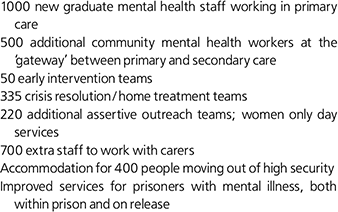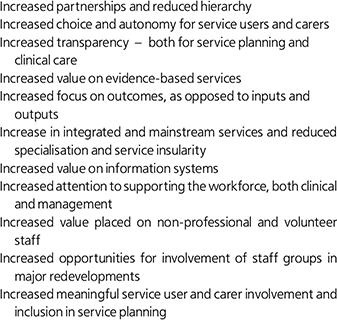When the NHS Plan (Department of Health, 2000a ) was unveiled in July 2000 it was heralded as promising a step change in the modernisation of the NHS in England. In fact mental health, as one of the Government's leading clinical priority areas, had already been the focus of considerable policy development. Modernising Mental Health Services (Department of Health, 1998) had set out a vision of services that would be ‘safe’, ‘sound’ and ‘supportive’ (with the policy emphasis firmly on the ‘safe’). It was followed by the publication of a mental health National Service Framework (NSF; Department of Health, 1999), revised and simplified, if highly prescriptive, guidelines for the Care Programme Approach (Department of Health, 2000b ) and a White Paper on reforming the Mental Health Act (Secretary for State & Home Secretary, 2000).
By the time the NHS Plan appeared a structure had already been put in place by the Department of Health to performance manage implementation of the mental health NSF — the local implementation team. In 2001 there were 126 local implementation teams, each representing a local health economy. Crucially the NHS Plan included a number of specific pledges for mental health service development by 2004, based on what later became a promised additional £300 million recurrent revenue (see Box 1). The first tranche of this revenue was hypothecated, that is, ring-fenced for the purposes set out in the NHS Plan.
Box 1. ‘What the National Plan will create’

| 1000 new graduate mental health staff working in primary care |
| 500 additional community mental health workers at the ‘gateway’ between primary and secondary care |
| 50 early intervention teams |
| 335 crisis resolution/home treatment teams |
| 220 additional assertive outreach teams; women only day services |
| 700 extra staff to work with carers |
| Accommodation for 400 people moving out of high security |
| Improved services for prisoners with mental illness, both within prison and on release |
| (Source: Department of Health, 2001a) |
Local implementation teams have been required to report on their progress in the implementation of the mental health NSF, the NHS Plan and a variety of other policy targets (for example, implementation of the recommendations of Safer Services (Reference Appleby, Shaw and SherrattAppleby et al, 2001). A cycle of self-assessment by local implementation teams of local implementation plans and feedback against a range of performance indicators, using a traffic-light system, enters its fourth iteration during 2002-2003. As part of this process data to enable the production of a detailed map of provision across England were collected in the Autumn of 2000 and, using more refined methodology, in 2001. Access to this Domesday book will be of enormous interest to practitioners and researchers.
The mental health policy implementation guide
A key text in understanding the modernisation agenda for mental health services is the policy implementation guide (Department of Health, 2001b ). Published in a loose-leaf binder (and available on the internet at http.//www.doh.gov.uk/pdfs/mentalhealthimplographics.pdf) it is intentionally a work in progress. The policy implementation guide envisages ‘whole systems change’, in line with the philosophy of modernisation. The initial version set out in some detail service specifications for three key components of secondary mental health care: crisis resolution/home treatment teams; assertive outreach teams; and early intervention services. In addition it included somewhat looser discussions about primary care mental health (which has clear commitments within the NHS Plan) and mental health promotion (enshrined within Standard one of the mental health NSF). Improving primary care mental health services along the lines envisaged within the mental health NSF by, for example, developing robust referral protocols that include advice on first-line treatment, might considerably decrease the burden on secondary mental health care.
The core sections of the policy implementation guide have an academic apparatus that provides justification for the proposed service developments. The plans have strong face validity, but may be criticised for going beyond the available evidence, as of course did the mental health NSF (NHS Centre for Reviews and Dissemination, 2001). The primary implementation guide also includes a chapter on tailoring services to local needs. It features a lengthy list of ‘changes in organisational and care culture that are required to achieve the modernisation agenda’ (pp. 86-87). This merits particularly close reading as a guide to overarching Department of Health priorities, and maps on to issues evaluated by the Commission for Health Improvement in their clinical governance reviews (see Box 2).
Box 2. ‘Changes in organisational and care culture that are required to achieve the modernisation agenda’

| Increased partnerships and reduced hierarchy |
| Increased choice and autonomy for service users and carers |
| Increased transparency — both for service planning and clinical care |
| Increased value on evidence-based services |
| Increased focus on outcomes, as opposed to inputs and outputs |
| Increase in integrated and mainstream services and reduced specialisation and service insularity |
| Increased value on information systems |
| Increased attention to supporting the workforce, both clinical and management |
| Increased value placed on non-professional and volunteer staff |
| Increased opportunities for involvement of staff groups in major redevelopments |
| Increased meaningful service user and carer involvement and inclusion in service planing |
| (Source: Department of Health, 2001b) |
Essentially the policy implementation guide envisages a functionally differentiated service system within which multiple specialist teams (primary care liaison, crisis resolution, assertive outreach and early onset) provide care to people referred for specialist mental health care, along the lines of the model developed in North Birmingham. This model can be seen as contrasting starkly with the current standard model of provision in England: the generic community mental health team (CMHT), which may or may not be able to refer on to services offering rehabilitation and continuing care. Crucially the policy implementation guide included a statement that: ‘It is not intended that where good services are in place, like well-functioning community mental health teams, that these services should be abandoned. New investment in these new functionalised teams will help overburdened in-patient and community services’ (p. 6).
After the policy implementation guide
A number of further initiatives have taken place post the policy implementation guide. Work has been undertaken on areas identified as priorities in it but lacking clear statements of how services should develop (women's services, services for people with personality disorder, dual diagnosis services, support to carers and links with the criminal justice system). A draft document on the CMHT was circulated for comment on an extremely tight time scale and definitive advice about the role and staffing of the CMHT that can be added to the policy implementation guide is to be published. A National Institute for Mental Health in England is being developed (Department of Health, 2001c ). This as yet somewhat sketchy organisation is to be led by the National Director for Mental Health (Professor Louis Appleby), and will include regionally-based mental health development centres, a national mental health research network and a series of time-limited development programmes.
The National Director has ensured that local implementation teams are required to have consultant advisers whose dual remit is to advise the team about implementation of the mental health NSF and NHS Plan and to ensure that consultant colleagues are engaged in the agenda for modernisation of mental health services. The President of the Royal College of Psychiatrists and the National Director jointly convened the first of a proposed series of meetings of consultant advisers in February 2002. Advisers have subsequently been offered additional training in change management.
Progress to date
Despite quite modest investment to date, most of which in the first year went to the burgeoning medium and low secure sector, the mental health NSF and NHS Plan have already led to rapid and quite profound system change. The most notable achievement has been in catalysing the integration of health and social services (a goal that had eluded the best efforts of policy makers for almost 30 years). Dialogue between primary and secondary care has been facilitated by the mental health NSF targets for primary mental health care.
The 2002 Budget confirmed that the NHS is to receive unprecedented growth monies over the next 5 years. This suggests that the ambitions expressed for mental health services in the mental health NSF and NHS Plan can be achieved. However, only modest additional funds were available during 2002-2003 to meet these ambitions (with more promised next year). Local implementation teams have had to prioritise essential service developments, following guidance from their performance managers, and the Modernisation Board was able to report that about 170 assertive outreach teams had been set up (Department of Health, 2002). Anecdotally, some local implementation teams have chosen to invest in the new services at the expense of existing CMHTs, while others have engaged in service redesign and have been able to maintain or even further invest in the core work of the CMHT. There is a real danger that those services choosing to disinvest in the CMHT will experience catastrophic failure at a time when expectations are running high, unless startling and immediate benefits accrue from the new services mandated by the policy implementation guide.
One further concern, underlined by consultant advisers, is the issue of workforce. All the money promised to the NHS will come to nothing if we cannot recruit staff to carry out the tasks required by the thoroughly modernised, radically redesigned health service. It is highly likely that this new service will require more trained psychiatrists, even with clever redesign of professional tasks and roles. Perhaps the National Director could expend some energy unblocking the expansion of senior house officer training posts in psychiatry.
Declaration of interest
None.





eLetters
No eLetters have been published for this article.